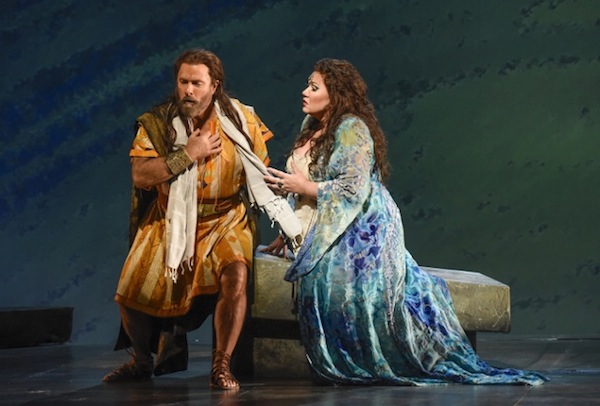Thrilling vocalism opens Dallas Opera season with “Samson et Dalila”

Clifton Forbis and Olga Borodina in Saint-Saëns’ “Samson et Dalila” at Dallas Opera. Photo: Karen Almond
It’s hard to imagine a way in which opening night of Dallas Opera’s 2017-18 season could have been bettered: two great singers complemented each other in the title roles of Saint-Saëns’ Samson et Dalila, set in an intriguing production that added a whole new dimension to this standard work from the 19th-century French repertoire.
Olga Borodina has very nearly made herself the leading Dalila of our time; you could almost swim in the full richness of her gorgeous tone, and she applies beautiful nuance to the vocal delicacies Saint-Saëns wrote into the score. Likewise, her presence within the role of the cruel seductress constantly captivates; at 54, the Russian singer convincingly portrays, through power of personality and unfailing musical and dramatic instinct, the role of a woman who destroys a great man and a nation. Her rendition of the famous aria “Mon cœur s’ouvre à ta voix” provided a moment to remember, and reminded why this set piece was long a favorite concert excerpt for mezzo-sopranos.
Likewise, the role of Samson might well have been written for tenor Clifton Forbis, a Dallas-based singer and member of the faculty of Southern Methodist University; his muscular dramatic tenor perfectly matches Borodina’s rich mezzo. The pair sang the roles together a decade ago in a production in San Francisco, and they clearly understand how to fit these parts together. Dramatically, Forbis convincingly finds the thread running through from the courageous, charismatic leader of ancient Israel to the ruined man who betrays his country and his god for the love of a woman.
The production, a hybrid featuring sets by Peter Dean Beck for Pittsburgh Opera and costumes created by Carrie Robbins for San Francisco Opera, provides an intriguing 21st-century take on a 19th-century French opera retelling of the the three-thousand-year-old tale. Beck’s initially barren, almost colorless properties gradually become more colorful, at first with Dalila’s introduction of sensuality, the intensity of color building to the final orgy scene. Robbins’ costumes are themselves an intriguing comment, with a sort of Game of Thrones, Iron-Age ambience but with some deliberate anachronisms, including the very blatant introduction of elements from traditional Orthodox Judaism for the ancient children of Israel, most notably with the numerous blue-and-white prayer shawls. A further appropriately disturbing but very subtle element appears in the final scene in which two of the captive Israelites wear striped robes evoking the garb of prisoners in Nazi concentration camps.
Stage director Bruno Berger-Gorski molds all these elements to give the production a dream-like quality that turns into a nightmarish horror story in the final scene. The turbulent crowd motion from earlier segments emerges as full-blown sensuality and, finally, an explosion of sadistic cruelty, complete with smearing of blood and whipping of captives; stop-action staging with wonderful lighting effects adds to the uncanny fascination and surrealistic quality of this spectacularly tragic moment.
A very strong supporting cast matched the vocal qualities of Borodina and Forbis, with baritone Richard Paul Fink as the High Priest of Dagon, baritone Michael Chioldi as Abimélech, and bass-baritone Ryan Kuster as the Old Hebrew. The Dallas Opera chorus filled the stage musically and dramatically, and an ensemble of dancers from Dallas Black Dance Theater, choreographed by Nycole Ray, contributed to the sensuality and decadence of the orgy scene.
Dallas Opera music director Emmanuel Villaume conducted with a sure sense of impetus and, as always in French repertoire, a wonderful insight into the relationship of the language to the music. Some weaknesses in the Dallas Opera Orchestra were exposed in Saint- Saëns’ more delicate passages, but the overall trajectory remained intact. Indeed, Villaume’s sense of timing was at times stunning, particularly in transitional moments, and with the offstage, unaccompanied laments of the Children of Israel in the final act.
In short, musical, vocal, visual, and dramatic elements come together for an always engaging, often thrilling production of a unique operatic masterpiece.
Dallas Opera’s production of Saint-Saëns’ Samson et Dalila will be repeated 2 p.m. Sunday and November 5, and 7:30 p.m. October 25 and 28 at Winspear Opera House. Pierre Vallet will conduct the performance on Wednesday. dallasopera.org; 214.443.1043